Patient Management in the Emergency Department: A Detailed Case Study
VerifiedAdded on 2021/04/24
|6
|1671
|248
Report
AI Summary
This report presents a case study analysis of patient care in an emergency department, focusing on the application of the Australasian Triage Scale for prioritizing patient assessment and treatment. The case involves Gail Peters, an elderly patient with multiple health conditions, whose initial assessment and subsequent care are examined in detail. The report discusses the allocation of the patient to the appropriate care unit, the necessity of specific diagnostic tests like electrocardiograms, and the importance of focused assessments on various body systems. Furthermore, it evaluates the effectiveness of the administered pain management strategies and addresses potential complications and concerns arising from prolonged stays in the emergency department, highlighting the impact on both patient well-being and nursing staff capabilities. Desklib offers a range of solved assignments and resources for students studying healthcare and emergency medicine.
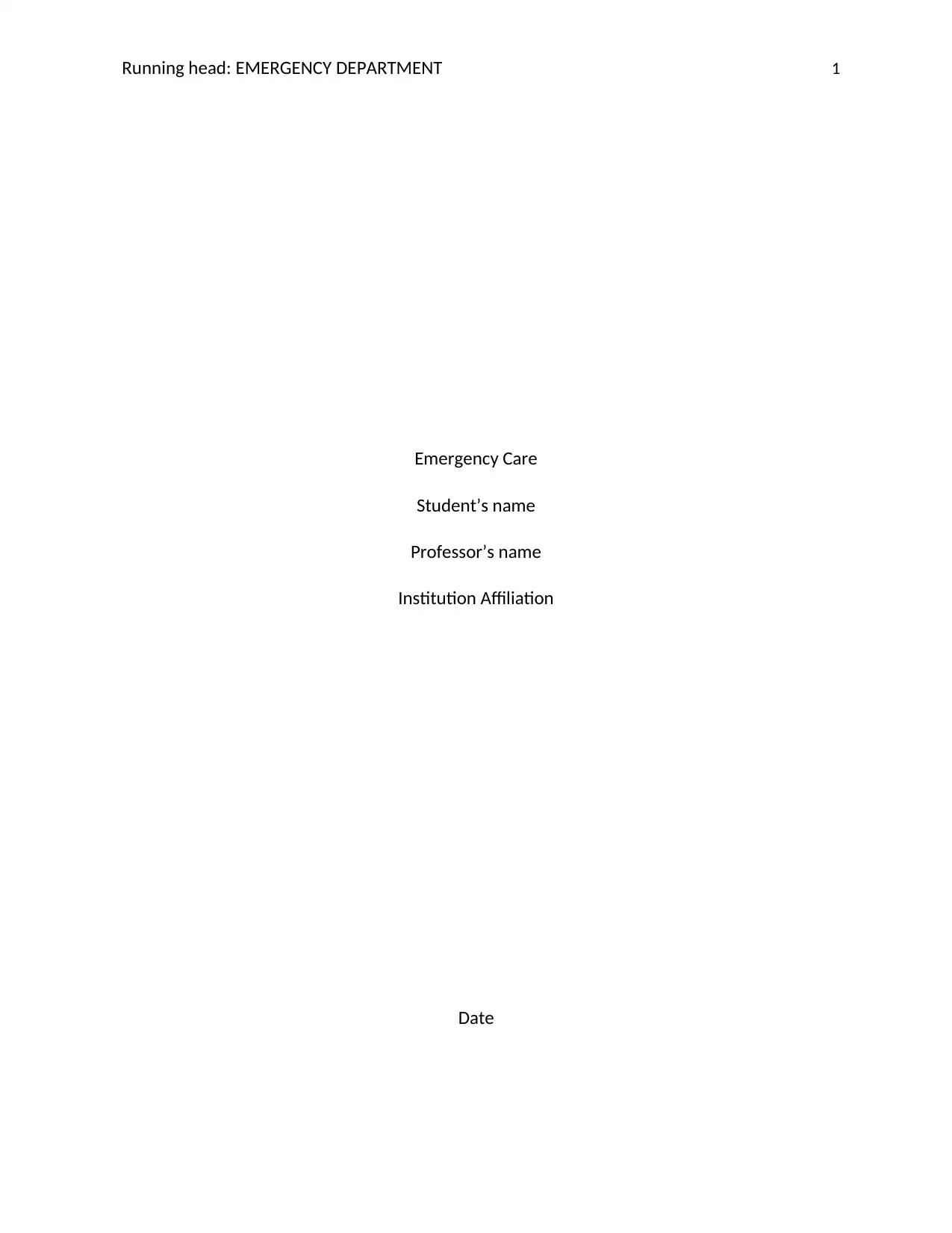
Running head: EMERGENCY DEPARTMENT 1
Emergency Care
Student’s name
Professor’s name
Institution Affiliation
Date
Emergency Care
Student’s name
Professor’s name
Institution Affiliation
Date
Paraphrase This Document
Need a fresh take? Get an instant paraphrase of this document with our AI Paraphraser
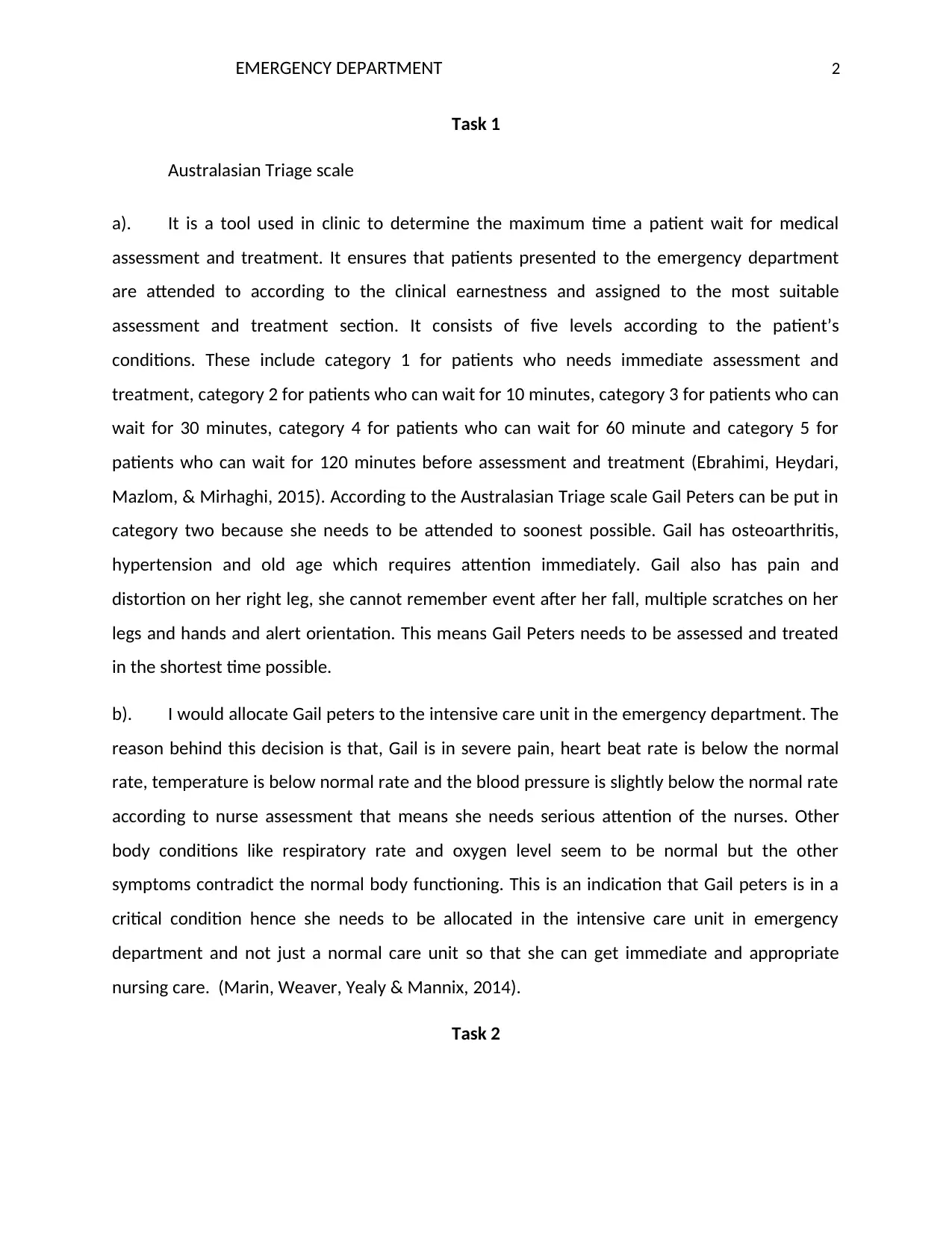
EMERGENCY DEPARTMENT 2
Task 1
Australasian Triage scale
a). It is a tool used in clinic to determine the maximum time a patient wait for medical
assessment and treatment. It ensures that patients presented to the emergency department
are attended to according to the clinical earnestness and assigned to the most suitable
assessment and treatment section. It consists of five levels according to the patient’s
conditions. These include category 1 for patients who needs immediate assessment and
treatment, category 2 for patients who can wait for 10 minutes, category 3 for patients who can
wait for 30 minutes, category 4 for patients who can wait for 60 minute and category 5 for
patients who can wait for 120 minutes before assessment and treatment (Ebrahimi, Heydari,
Mazlom, & Mirhaghi, 2015). According to the Australasian Triage scale Gail Peters can be put in
category two because she needs to be attended to soonest possible. Gail has osteoarthritis,
hypertension and old age which requires attention immediately. Gail also has pain and
distortion on her right leg, she cannot remember event after her fall, multiple scratches on her
legs and hands and alert orientation. This means Gail Peters needs to be assessed and treated
in the shortest time possible.
b). I would allocate Gail peters to the intensive care unit in the emergency department. The
reason behind this decision is that, Gail is in severe pain, heart beat rate is below the normal
rate, temperature is below normal rate and the blood pressure is slightly below the normal rate
according to nurse assessment that means she needs serious attention of the nurses. Other
body conditions like respiratory rate and oxygen level seem to be normal but the other
symptoms contradict the normal body functioning. This is an indication that Gail peters is in a
critical condition hence she needs to be allocated in the intensive care unit in emergency
department and not just a normal care unit so that she can get immediate and appropriate
nursing care. (Marin, Weaver, Yealy & Mannix, 2014).
Task 2
Task 1
Australasian Triage scale
a). It is a tool used in clinic to determine the maximum time a patient wait for medical
assessment and treatment. It ensures that patients presented to the emergency department
are attended to according to the clinical earnestness and assigned to the most suitable
assessment and treatment section. It consists of five levels according to the patient’s
conditions. These include category 1 for patients who needs immediate assessment and
treatment, category 2 for patients who can wait for 10 minutes, category 3 for patients who can
wait for 30 minutes, category 4 for patients who can wait for 60 minute and category 5 for
patients who can wait for 120 minutes before assessment and treatment (Ebrahimi, Heydari,
Mazlom, & Mirhaghi, 2015). According to the Australasian Triage scale Gail Peters can be put in
category two because she needs to be attended to soonest possible. Gail has osteoarthritis,
hypertension and old age which requires attention immediately. Gail also has pain and
distortion on her right leg, she cannot remember event after her fall, multiple scratches on her
legs and hands and alert orientation. This means Gail Peters needs to be assessed and treated
in the shortest time possible.
b). I would allocate Gail peters to the intensive care unit in the emergency department. The
reason behind this decision is that, Gail is in severe pain, heart beat rate is below the normal
rate, temperature is below normal rate and the blood pressure is slightly below the normal rate
according to nurse assessment that means she needs serious attention of the nurses. Other
body conditions like respiratory rate and oxygen level seem to be normal but the other
symptoms contradict the normal body functioning. This is an indication that Gail peters is in a
critical condition hence she needs to be allocated in the intensive care unit in emergency
department and not just a normal care unit so that she can get immediate and appropriate
nursing care. (Marin, Weaver, Yealy & Mannix, 2014).
Task 2
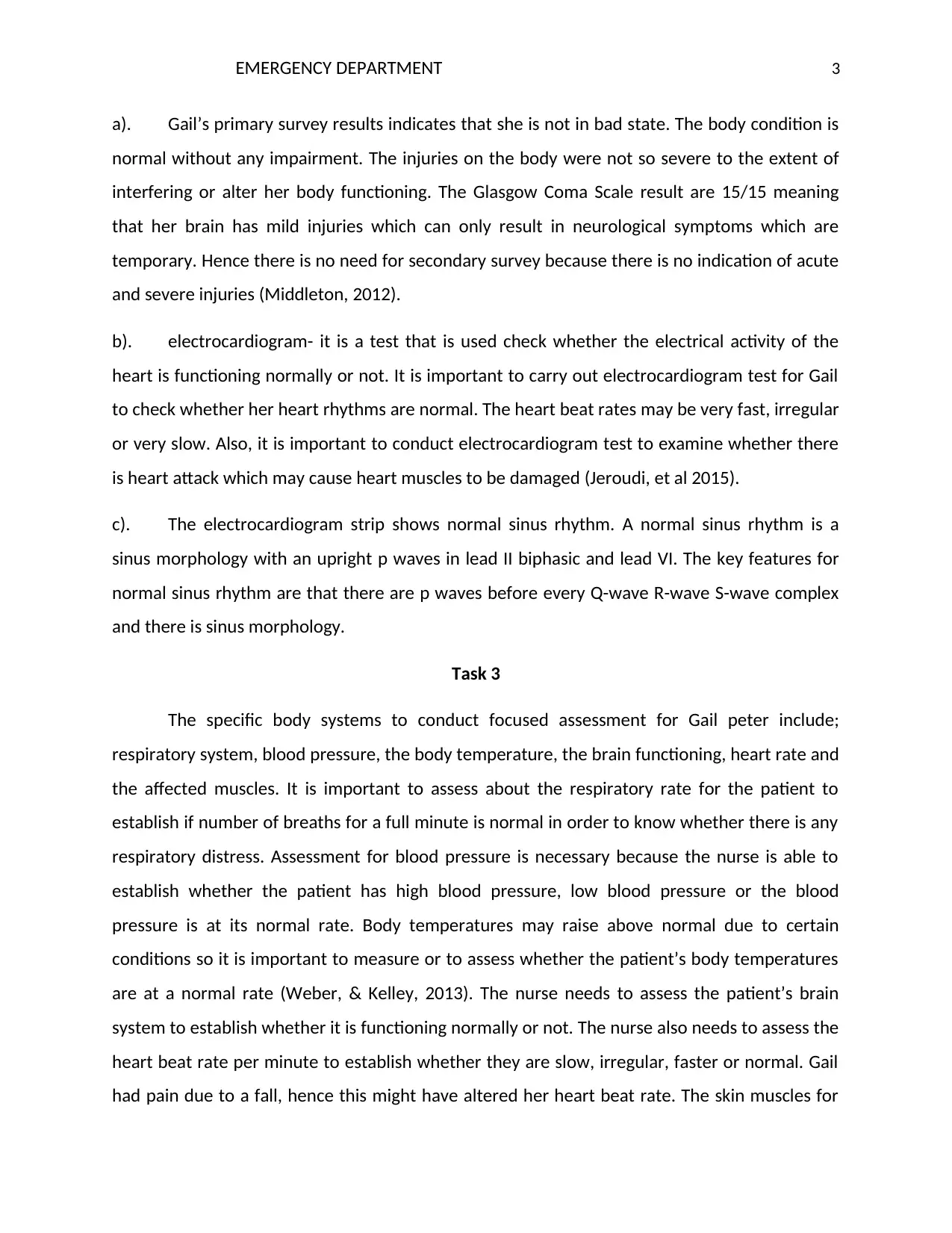
EMERGENCY DEPARTMENT 3
a). Gail’s primary survey results indicates that she is not in bad state. The body condition is
normal without any impairment. The injuries on the body were not so severe to the extent of
interfering or alter her body functioning. The Glasgow Coma Scale result are 15/15 meaning
that her brain has mild injuries which can only result in neurological symptoms which are
temporary. Hence there is no need for secondary survey because there is no indication of acute
and severe injuries (Middleton, 2012).
b). electrocardiogram- it is a test that is used check whether the electrical activity of the
heart is functioning normally or not. It is important to carry out electrocardiogram test for Gail
to check whether her heart rhythms are normal. The heart beat rates may be very fast, irregular
or very slow. Also, it is important to conduct electrocardiogram test to examine whether there
is heart attack which may cause heart muscles to be damaged (Jeroudi, et al 2015).
c). The electrocardiogram strip shows normal sinus rhythm. A normal sinus rhythm is a
sinus morphology with an upright p waves in lead II biphasic and lead VI. The key features for
normal sinus rhythm are that there are p waves before every Q-wave R-wave S-wave complex
and there is sinus morphology.
Task 3
The specific body systems to conduct focused assessment for Gail peter include;
respiratory system, blood pressure, the body temperature, the brain functioning, heart rate and
the affected muscles. It is important to assess about the respiratory rate for the patient to
establish if number of breaths for a full minute is normal in order to know whether there is any
respiratory distress. Assessment for blood pressure is necessary because the nurse is able to
establish whether the patient has high blood pressure, low blood pressure or the blood
pressure is at its normal rate. Body temperatures may raise above normal due to certain
conditions so it is important to measure or to assess whether the patient’s body temperatures
are at a normal rate (Weber, & Kelley, 2013). The nurse needs to assess the patient’s brain
system to establish whether it is functioning normally or not. The nurse also needs to assess the
heart beat rate per minute to establish whether they are slow, irregular, faster or normal. Gail
had pain due to a fall, hence this might have altered her heart beat rate. The skin muscles for
a). Gail’s primary survey results indicates that she is not in bad state. The body condition is
normal without any impairment. The injuries on the body were not so severe to the extent of
interfering or alter her body functioning. The Glasgow Coma Scale result are 15/15 meaning
that her brain has mild injuries which can only result in neurological symptoms which are
temporary. Hence there is no need for secondary survey because there is no indication of acute
and severe injuries (Middleton, 2012).
b). electrocardiogram- it is a test that is used check whether the electrical activity of the
heart is functioning normally or not. It is important to carry out electrocardiogram test for Gail
to check whether her heart rhythms are normal. The heart beat rates may be very fast, irregular
or very slow. Also, it is important to conduct electrocardiogram test to examine whether there
is heart attack which may cause heart muscles to be damaged (Jeroudi, et al 2015).
c). The electrocardiogram strip shows normal sinus rhythm. A normal sinus rhythm is a
sinus morphology with an upright p waves in lead II biphasic and lead VI. The key features for
normal sinus rhythm are that there are p waves before every Q-wave R-wave S-wave complex
and there is sinus morphology.
Task 3
The specific body systems to conduct focused assessment for Gail peter include;
respiratory system, blood pressure, the body temperature, the brain functioning, heart rate and
the affected muscles. It is important to assess about the respiratory rate for the patient to
establish if number of breaths for a full minute is normal in order to know whether there is any
respiratory distress. Assessment for blood pressure is necessary because the nurse is able to
establish whether the patient has high blood pressure, low blood pressure or the blood
pressure is at its normal rate. Body temperatures may raise above normal due to certain
conditions so it is important to measure or to assess whether the patient’s body temperatures
are at a normal rate (Weber, & Kelley, 2013). The nurse needs to assess the patient’s brain
system to establish whether it is functioning normally or not. The nurse also needs to assess the
heart beat rate per minute to establish whether they are slow, irregular, faster or normal. Gail
had pain due to a fall, hence this might have altered her heart beat rate. The skin muscles for
⊘ This is a preview!⊘
Do you want full access?
Subscribe today to unlock all pages.

Trusted by 1+ million students worldwide
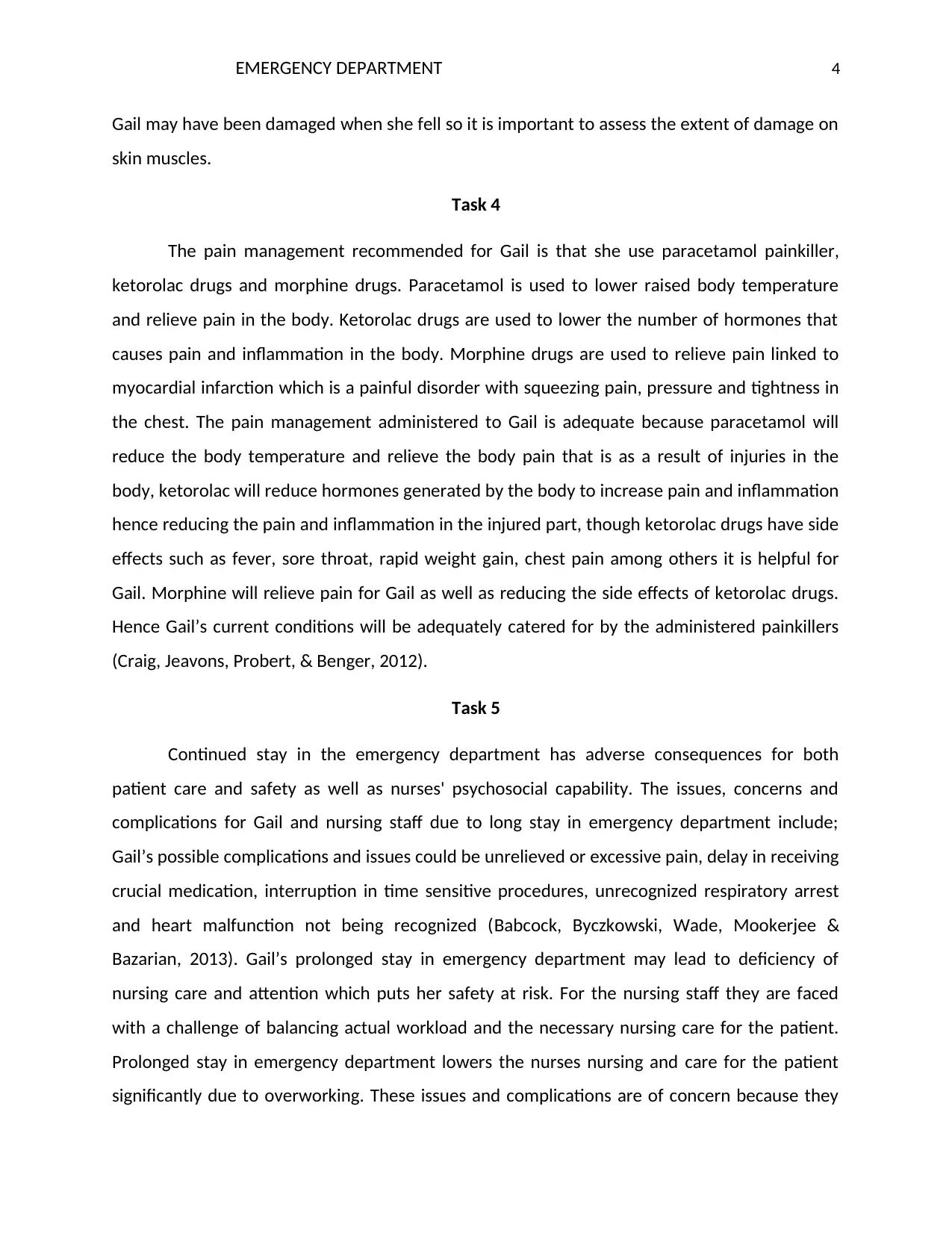
EMERGENCY DEPARTMENT 4
Gail may have been damaged when she fell so it is important to assess the extent of damage on
skin muscles.
Task 4
The pain management recommended for Gail is that she use paracetamol painkiller,
ketorolac drugs and morphine drugs. Paracetamol is used to lower raised body temperature
and relieve pain in the body. Ketorolac drugs are used to lower the number of hormones that
causes pain and inflammation in the body. Morphine drugs are used to relieve pain linked to
myocardial infarction which is a painful disorder with squeezing pain, pressure and tightness in
the chest. The pain management administered to Gail is adequate because paracetamol will
reduce the body temperature and relieve the body pain that is as a result of injuries in the
body, ketorolac will reduce hormones generated by the body to increase pain and inflammation
hence reducing the pain and inflammation in the injured part, though ketorolac drugs have side
effects such as fever, sore throat, rapid weight gain, chest pain among others it is helpful for
Gail. Morphine will relieve pain for Gail as well as reducing the side effects of ketorolac drugs.
Hence Gail’s current conditions will be adequately catered for by the administered painkillers
(Craig, Jeavons, Probert, & Benger, 2012).
Task 5
Continued stay in the emergency department has adverse consequences for both
patient care and safety as well as nurses' psychosocial capability. The issues, concerns and
complications for Gail and nursing staff due to long stay in emergency department include;
Gail’s possible complications and issues could be unrelieved or excessive pain, delay in receiving
crucial medication, interruption in time sensitive procedures, unrecognized respiratory arrest
and heart malfunction not being recognized (Babcock, Byczkowski, Wade, Mookerjee &
Bazarian, 2013). Gail’s prolonged stay in emergency department may lead to deficiency of
nursing care and attention which puts her safety at risk. For the nursing staff they are faced
with a challenge of balancing actual workload and the necessary nursing care for the patient.
Prolonged stay in emergency department lowers the nurses nursing and care for the patient
significantly due to overworking. These issues and complications are of concern because they
Gail may have been damaged when she fell so it is important to assess the extent of damage on
skin muscles.
Task 4
The pain management recommended for Gail is that she use paracetamol painkiller,
ketorolac drugs and morphine drugs. Paracetamol is used to lower raised body temperature
and relieve pain in the body. Ketorolac drugs are used to lower the number of hormones that
causes pain and inflammation in the body. Morphine drugs are used to relieve pain linked to
myocardial infarction which is a painful disorder with squeezing pain, pressure and tightness in
the chest. The pain management administered to Gail is adequate because paracetamol will
reduce the body temperature and relieve the body pain that is as a result of injuries in the
body, ketorolac will reduce hormones generated by the body to increase pain and inflammation
hence reducing the pain and inflammation in the injured part, though ketorolac drugs have side
effects such as fever, sore throat, rapid weight gain, chest pain among others it is helpful for
Gail. Morphine will relieve pain for Gail as well as reducing the side effects of ketorolac drugs.
Hence Gail’s current conditions will be adequately catered for by the administered painkillers
(Craig, Jeavons, Probert, & Benger, 2012).
Task 5
Continued stay in the emergency department has adverse consequences for both
patient care and safety as well as nurses' psychosocial capability. The issues, concerns and
complications for Gail and nursing staff due to long stay in emergency department include;
Gail’s possible complications and issues could be unrelieved or excessive pain, delay in receiving
crucial medication, interruption in time sensitive procedures, unrecognized respiratory arrest
and heart malfunction not being recognized (Babcock, Byczkowski, Wade, Mookerjee &
Bazarian, 2013). Gail’s prolonged stay in emergency department may lead to deficiency of
nursing care and attention which puts her safety at risk. For the nursing staff they are faced
with a challenge of balancing actual workload and the necessary nursing care for the patient.
Prolonged stay in emergency department lowers the nurses nursing and care for the patient
significantly due to overworking. These issues and complications are of concern because they
Paraphrase This Document
Need a fresh take? Get an instant paraphrase of this document with our AI Paraphraser
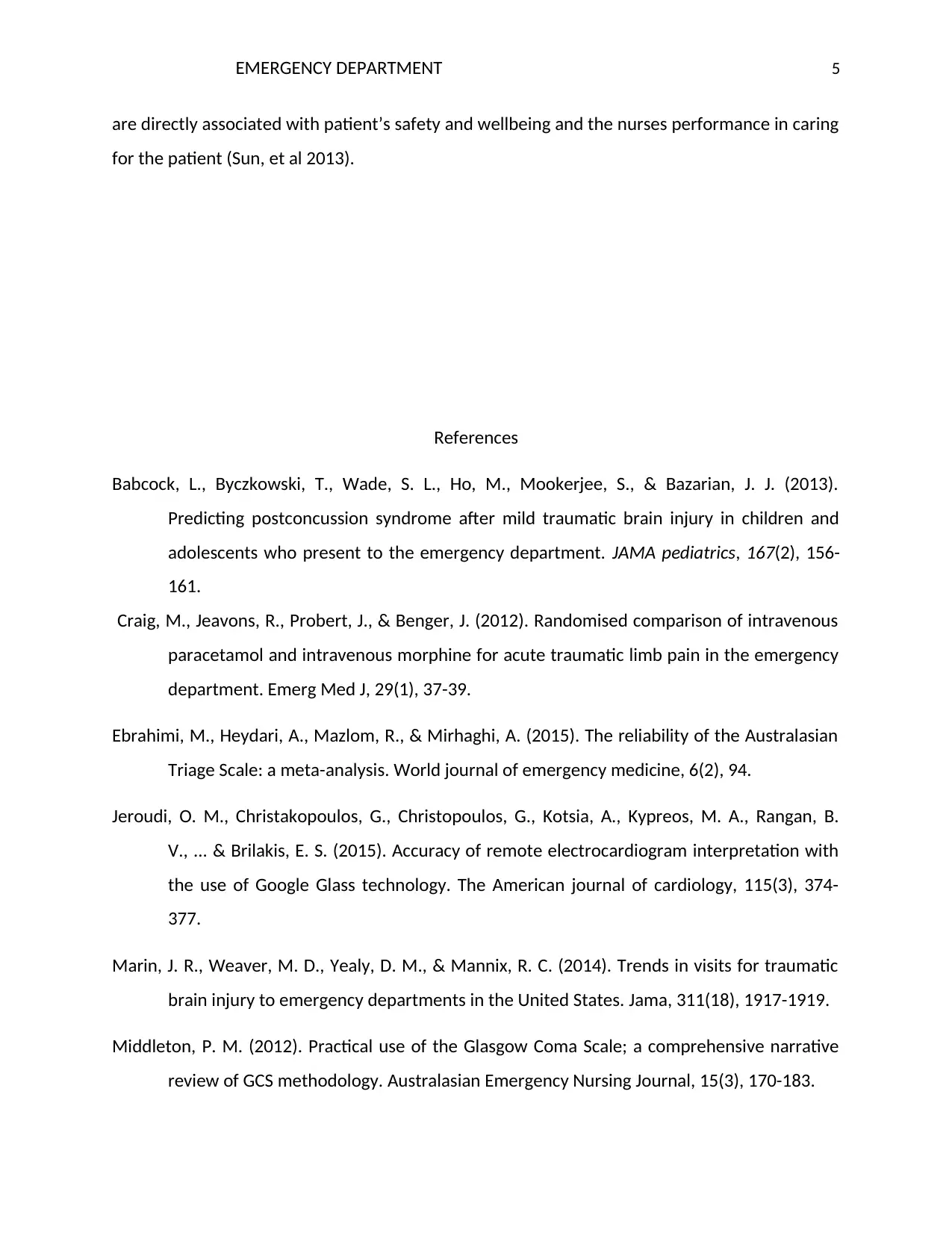
EMERGENCY DEPARTMENT 5
are directly associated with patient’s safety and wellbeing and the nurses performance in caring
for the patient (Sun, et al 2013).
References
Babcock, L., Byczkowski, T., Wade, S. L., Ho, M., Mookerjee, S., & Bazarian, J. J. (2013).
Predicting postconcussion syndrome after mild traumatic brain injury in children and
adolescents who present to the emergency department. JAMA pediatrics, 167(2), 156-
161.
Craig, M., Jeavons, R., Probert, J., & Benger, J. (2012). Randomised comparison of intravenous
paracetamol and intravenous morphine for acute traumatic limb pain in the emergency
department. Emerg Med J, 29(1), 37-39.
Ebrahimi, M., Heydari, A., Mazlom, R., & Mirhaghi, A. (2015). The reliability of the Australasian
Triage Scale: a meta-analysis. World journal of emergency medicine, 6(2), 94.
Jeroudi, O. M., Christakopoulos, G., Christopoulos, G., Kotsia, A., Kypreos, M. A., Rangan, B.
V., ... & Brilakis, E. S. (2015). Accuracy of remote electrocardiogram interpretation with
the use of Google Glass technology. The American journal of cardiology, 115(3), 374-
377.
Marin, J. R., Weaver, M. D., Yealy, D. M., & Mannix, R. C. (2014). Trends in visits for traumatic
brain injury to emergency departments in the United States. Jama, 311(18), 1917-1919.
Middleton, P. M. (2012). Practical use of the Glasgow Coma Scale; a comprehensive narrative
review of GCS methodology. Australasian Emergency Nursing Journal, 15(3), 170-183.
are directly associated with patient’s safety and wellbeing and the nurses performance in caring
for the patient (Sun, et al 2013).
References
Babcock, L., Byczkowski, T., Wade, S. L., Ho, M., Mookerjee, S., & Bazarian, J. J. (2013).
Predicting postconcussion syndrome after mild traumatic brain injury in children and
adolescents who present to the emergency department. JAMA pediatrics, 167(2), 156-
161.
Craig, M., Jeavons, R., Probert, J., & Benger, J. (2012). Randomised comparison of intravenous
paracetamol and intravenous morphine for acute traumatic limb pain in the emergency
department. Emerg Med J, 29(1), 37-39.
Ebrahimi, M., Heydari, A., Mazlom, R., & Mirhaghi, A. (2015). The reliability of the Australasian
Triage Scale: a meta-analysis. World journal of emergency medicine, 6(2), 94.
Jeroudi, O. M., Christakopoulos, G., Christopoulos, G., Kotsia, A., Kypreos, M. A., Rangan, B.
V., ... & Brilakis, E. S. (2015). Accuracy of remote electrocardiogram interpretation with
the use of Google Glass technology. The American journal of cardiology, 115(3), 374-
377.
Marin, J. R., Weaver, M. D., Yealy, D. M., & Mannix, R. C. (2014). Trends in visits for traumatic
brain injury to emergency departments in the United States. Jama, 311(18), 1917-1919.
Middleton, P. M. (2012). Practical use of the Glasgow Coma Scale; a comprehensive narrative
review of GCS methodology. Australasian Emergency Nursing Journal, 15(3), 170-183.

EMERGENCY DEPARTMENT 6
Sun, B. C., Hsia, R. Y., Weiss, R. E., Zingmond, D., Liang, L. J., Han, W., ... & Asch, S. M. (2013).
Effect of emergency department crowding on outcomes of admitted patients. Annals of
emergency medicine, 61(6), 605-611.
Weber, J. R., & Kelley, J. H. (2013). Health assessment in nursing. Lippincott Williams & Wilkins.
Sun, B. C., Hsia, R. Y., Weiss, R. E., Zingmond, D., Liang, L. J., Han, W., ... & Asch, S. M. (2013).
Effect of emergency department crowding on outcomes of admitted patients. Annals of
emergency medicine, 61(6), 605-611.
Weber, J. R., & Kelley, J. H. (2013). Health assessment in nursing. Lippincott Williams & Wilkins.
⊘ This is a preview!⊘
Do you want full access?
Subscribe today to unlock all pages.

Trusted by 1+ million students worldwide
1 out of 6
Related Documents
Your All-in-One AI-Powered Toolkit for Academic Success.
+13062052269
info@desklib.com
Available 24*7 on WhatsApp / Email
![[object Object]](/_next/static/media/star-bottom.7253800d.svg)
Unlock your academic potential
Copyright © 2020–2025 A2Z Services. All Rights Reserved. Developed and managed by ZUCOL.





